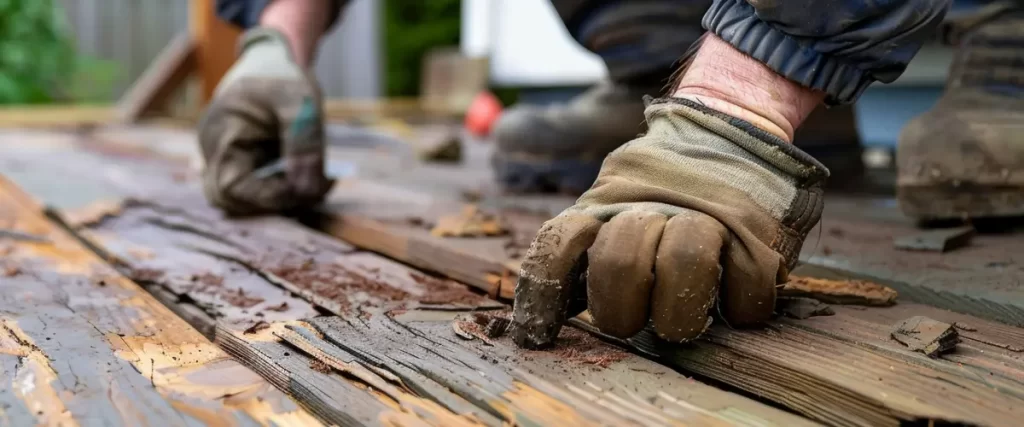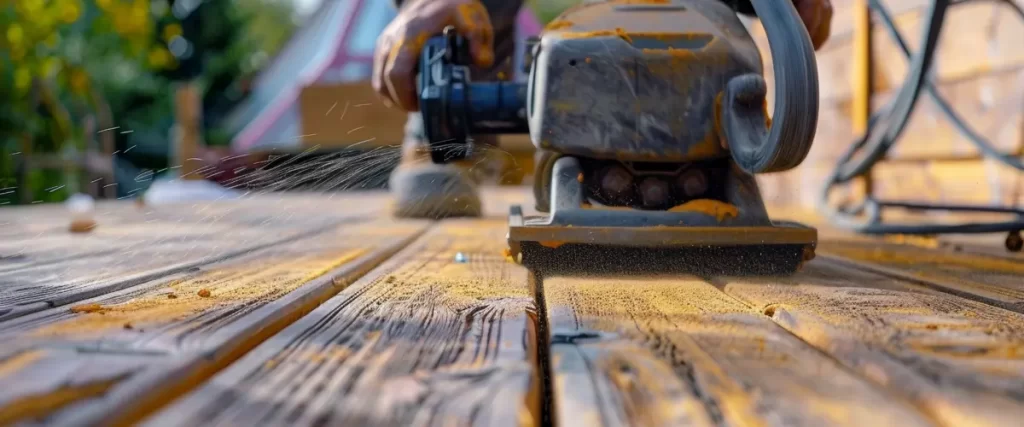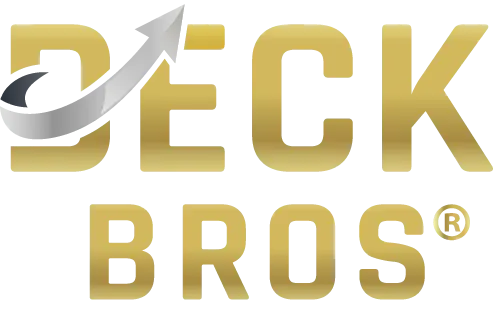Your deck is a great place to relax, host gatherings, or enjoy a quiet evening. However, over time, wear and tear can take a toll, leading to structural damage that might make the deck unsafe. Knowing the signs of structural damage in a deck is crucial for keeping your family and friends safe. Let’s walk through the common warning signs and what you can do to fix them.

1. Sagging or Warped Deck Boards
One of the first signs of trouble is sagging or warped deck boards. Over time, these boards can weaken due to weather, heavy use, or poor-quality materials. Warped boards not only look unsightly but can also pose a safety hazard. If your composite decking shows signs of bending or sagging, it may need to be replaced. Similarly, traditional wood decks are especially vulnerable to these issues, as the material is prone to warping when exposed to moisture.
2. Rotting Wood
Wood rot is a clear indication of structural damage. It occurs when moisture seeps into wooden parts of your deck, like deck posts or railings. Once the wood begins to rot, the structural integrity of the entire deck is compromised. To check for rot, look for soft spots, discoloration, or areas where the wood crumbles easily. Rotting deck stairs or deck posts can quickly become a safety hazard, so addressing the issue promptly is essential.
3. Loose or Missing Fasteners
Fasteners hold your deck together, so loose or missing fasteners can make the structure unstable. Inspect the screws, nails, and bolts regularly. If you notice gaps between the boards or deck railings that feel wobbly, it’s time to act. While tightening fasteners can be a temporary fix, replacing damaged ones is often necessary to maintain the structural integrity of your deck.
4. Cracked or Splitting Deck Posts
Deck posts provide the foundation for your deck. Cracks or splits in these posts can compromise the deck’s stability. Whether your deck is made of composite decking materials or traditional wood, damaged posts are a serious issue. Check for cracks, leaning, or shifting in the deck posts, as these are all signs of structural damage.
5. Unstable Deck Railings
Deck railings are vital for safety, especially if your deck is elevated. Loose railings or those that wobble when leaned on are a red flag. Wobbly railings can quickly turn into a safety hazard, putting you and your guests at risk. Whether you have composite decking or a wooden deck, ensuring the railings are secure is critical for keeping your deck safe.
6. Uneven or Sinking Deck Stairs
Deck stairs are often overlooked, but they play an essential role in the deck’s structural integrity. Uneven or sinking stairs can indicate problems with the deck’s foundation or deck posts. If your deck stairs feel unstable or show signs of movement, it’s time to have your deck inspected.
7. Discoloration or Fading
While discoloration may seem like a cosmetic issue, it can also signal deeper structural damage. For example, faded composite decking may indicate material breakdown, while dark spots on wood might be a sign of moisture problems or wood rot.
8. Deck Boards That Shift
Deck boards that shift when walked on are a common problem. This issue is often caused by loose or missing fasteners. If left unaddressed, shifting boards can weaken the deck structure and create a safety hazard.
9. Signs of Insect Damage
Insects, such as termites, can cause significant damage to a wooden deck. Look for small holes, sawdust, or areas where the wood appears to be hollowed out. Insect damage can compromise your deck’s structural integrity, making it unsafe over time.
10. Age of the Deck
The age of your deck can also be a factor. Even the most durable composite decking materials wear down over time. If your deck is over 10–15 years old, it’s a good idea to have it inspected, even if there are no visible signs of damage.
Adding More Tools for Seamless Deck Repairs
When it comes to DIY deck repairs, a few extra tools can make your work even more efficient and enjoyable. Let’s add to your toolkit with a couple of bonus recommendations that will save time and ensure high-quality results.
Chalk Line
A chalk line is an incredibly useful tool for marking straight lines on your deck boards before cutting or drilling. It helps maintain precision and ensures your cuts and placements are aligned, giving your deck a clean, professional finish. Whether you’re installing new deck boards or making adjustments to your existing structure, this tool is a game-changer.
Socket Wrench Set
Deck repairs often involve tightening bolts or nuts, especially for railings or joist hangers. A socket wrench set allows you to securely fasten these components, ensuring your deck’s stability and safety. It’s an essential tool for projects requiring extra strength and durability.
Carpenter’s Square
For precise corners and angles, a carpenter’s square is indispensable. Use it when cutting deck boards or installing joist hangers to ensure everything fits perfectly. This small tool goes a long way in maintaining your deck’s structural integrity and aesthetic appeal.
Spare Materials
While not technically a tool, having spare materials like extra deck boards, screws, and joist hangers on hand can save you a lot of time. Running out of supplies mid-project can delay your repairs, so keeping extras ready ensures a smooth workflow.
With these additional tools, your DIY deck repair toolkit is now fully equipped to handle any challenge! And remember, if you’re ever unsure or need professional assistance, Deck Bros is just a call away. Let us take the hassle out of repairs and deliver results you’ll love.
What Should You Do If You See Issues With Your Deck?
If you notice any of these issues, take action quickly. Start by scheduling a professional inspection to assess the damage. Small repairs, like replacing a few loose fasteners or damaged deck boards, can help your deck remain safe for now. However, if the structural damage is extensive, you may need to consider a deck replacement.
Composite decking is a great option if you’re planning to replace your deck. It’s durable, low-maintenance, and resistant to issues like wood rot or insect damage. Whether you’re repairing or rebuilding, keeping your deck in top condition is essential for safety and longevity.
FAQ
1. How do I know if my deck is unsafe?
Check for loose railings, warped boards, wood rot, or any instability in the deck posts or stairs. These are common signs that your deck may be unsafe.
2. What is the lifespan of a deck?
A well-maintained deck can last 10–15 years, but this varies based on materials, weather conditions, and maintenance.
3. Can I repair my deck instead of replacing it?
Yes, small issues like loose or missing fasteners or warped deck boards can often be repaired. However, extensive damage may require a replacement.
4. What is composite decking?
Composite decking is made from a mix of wood fibers and plastic. It’s durable, low-maintenance, and resistant to rot and insect damage, making it a popular choice for new decks.
5. How often should I inspect my deck?
Inspect your deck at least once a year, especially after winter or rainy seasons, to ensure its structural integrity.

The Deck Of Your Dreams
Your deck should be a place of comfort, not worry. By identifying the signs of structural damage early and addressing them promptly, you can ensure your deck remains safe and enjoyable for years to come.
If you’re noticing problems with your deck or considering a new deck, contact Deck Bros today at (402) 369-5724. We’ll help you determine whether you need repairs or a complete deck replacement, ensuring your outdoor space is both beautiful and secure.
You can also get in touch today, and let’s upgrade your space!
